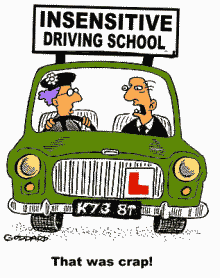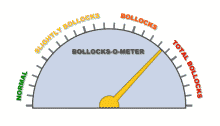
I saw this cartoon and it made me laugh.
Funnily enough, though, I sometimes use that line with my pupils! When I know I can get away with it, of course.
But it’s even better when I ask them how they thought something went – when it didn’t – and they say it themselves.
On a slightly different note, I was out with a pupil yesterday. He is classic “that was crap” territory – everything he does is “absolute shit” unless it is 100% right in his eyes. Even when what he’s done is perfectly OK, he’ll decide it isn’t and go into a sulk over it.
One of his more irritating habits is his defensiveness, which often manifests itself as having an answer for everything. I may have mentioned before the time when I was trying to get him to tell me why getting too close to the kerb with the risk of hitting it is dangerous and expensive. I’d managed to get to the part about the damage it can do to the tyre, and asked rhetorically who he thought had to pay for it. He came back with “Me! I’ll pay for it, obviously.”
I just said “look. Let’s get this straight. You are NOT going to drive into the kerb”.
Anyway, he was off on another of his bizarre thought process excursions yesterday. He’d stalled at a roundabout by trying to move off too quickly in the wrong gear. He was annoyed that he’d done it, so it snowballed for a few hundred metres (with him forgetting to get in lane for a right turn, not checking his mirrors or signalling, and so on) until I could pull him over.
Now, the reason he’d messed up on the roundabout was dead simple. He’d intended not to stop, was going too fast as a result, had to stop for a car which appeared after he’d made his initial decision to go, then rushed moving off without having changed gear.
His explanation was far more entertaining, though. He started with:
Well, let me just stop you there. I can tell you exactly why that happened. About 40 seconds ago further down the road…

At this point, my “You’re Talking Total Bollocks-o-meter” had maxed out… he continued with some stuff about another car, and how it had distracted him by pulling out. I listened patiently until he’d finished. I just said “I’m sorry, but that’s a load of bollocks, Dave!”
I went on to question why something that happened 40 seconds ago should in any way justify a dangerous attempt to pull out without checking properly and the subsequent need to brake harshly. I questioned why the same event had apparently led to dangerous omissions from that point onward.
I asked him if it would be OK to drive into a brick wall at 70mph, just because another car had caused some sort of distraction.
He had to admit that it wouldn’t.
From there, we had a chance to discuss the importance of planning ahead and not backwards.




